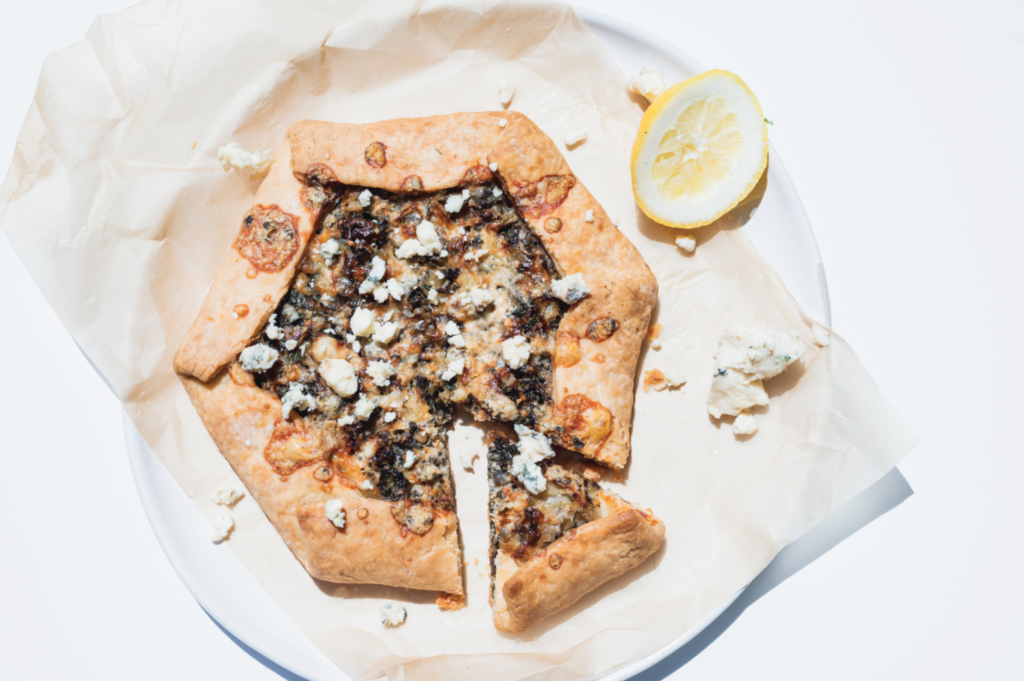Whether they are sweet or savory, galettes are a delicious representation of the expression “more than the sum of its parts.” While the individual components of a galette—crust, base ingredient, and toppings—may seem plain at first look, together they create a centerpiece-worthy dish that is easy to make and flexible enough for any meal.
With casual, folded sides and (sometimes) a top crust, galettes are decidedly more freeform and less fussy than pies or tarts. They provide an easy foundation for everything from tender spring greens and ripe summer fruits to autumn squashes and winter root vegetables.
These crusts—which can be the same as pie crusts—are easily made in batches and kept frozen for quick mealtime inspiration. We like to thaw out a few at the beginning of each week to keep handy for mid-week and weekend impromptu galette making, often using both a few key ingredients alongside leftovers and extra sauces.
The following savory, vegetarian galette recipes also offer an additional advantage in that the fillings don’t emit much moisture (thereby potentially compromising the crust). Each is topped with a generous helping of melty cheese that can be finished under the broiler for extra texture.
—First, The Crust—
Galette crusts are made from a variety of doughs, including sweet or savory pie crust dough and puff pastry. The most important aspect of the crust is that it is sturdy enough to hold the galette filling without leaking, but thin enough they cook evenly without a par-bake (or “blind bake”), since the galette crust bakes along with the filling (unlike many pies).
Most standard pie crust recipes—or store-bought raw pie crusts you find in sleeves at the supermarket—make fine galette crusts for both savory and sweet applications. Just avoid pre-formed crusts, since you won’t have control informing the folded sides that are the hallmark of a galette.
For gluten-free or grain-free eaters, galettes are a little more forgiving than pie crusts in that they can be less uniform in shape and more rustic. Combinations of rice flour, oat flour, and tapioca starch are excellent places to start for a gluten-free variation; if you want an extra nutty note, try quinoa flour too. On the grain-free side, almond flour and coconut flour is a tried-and-true combination. As long as your dough isn’t too crumbly or loose and can be rolled into a flat, circular piece, it will generally hold up in the baking process.
50/50 Whole Wheat Pie or Galette Crust
Ingredients
- ¾ cup whole wheat flour
- ¾ cup all-purpose flour
- 1 teaspoon kosher salt
- 1 teaspoon white sugar
- ½ cup cold butter cubed
- ¼ cup cold water
Instructions
- ►In food processor, add flour, salt and sugar. Pulse to combine. Add butter, and run food processor until mixture looks like lightly coarse sand. With the food processor still running, add cold water until mixture combines together as a ball.
- ►Gather together mixture and knead gently into a flat disc. Wrap in plastic and store in refrigerator (or freezer for storage of up to six months). Let crust come to room temperature before rolling into a circle. (If frozen, let thaw overnight in refrigerator.)
—History And Tradition—
The word galette comes from the ancient Norman word gale, which translates into “flat cake.” Consistent with the name, it’s usually made from one layer of pastry crust, typically molded over the center filling and folded into overlapping edges around the entirety of the “cake.”
Galettes are distinguished from tarts by their rustic, folded edges and by the fact that they are constructed on a baking sheet instead of in a tart pan with sides. There are some similarities, however: galettes can also be made from a variety of doughs, and they also show up on menus from day to night, sweet to savory.
While the word galette typically conjures up a specific image, there are some notable exceptions. One is the Breton galette, which hails from the Brittany region in western France and looks more akin to a crepe with its square sides and thin, fluffy wrapper. The batter is made from buckwheat flour and it’s often filled with ham, Gruyere, and egg.
Another specialty galette is the galette de rois, known in the United States as king’s cake. It is eaten during the celebration of Epiphany, at the end of the Christmas season, the day where the three kings (les rois) are said to have visited the baby Jesus. There are different variations of a king’s cake across the world, from Portugal to New Orleans; in Northern France, the galette de rois version is made of puff pastry, stuffed with apple or frangipane (almond custard), and features a top crust. A small trinket, known in French as the fève (these include anything from a tiny plastic baby to a whole almond—it’s up to the discretion of the baker) is hidden inside. Tradition holds that whoever receives the piece of galette with the fève is crowned “queen or king for a day.”
—Wrap Up Those Leftovers—
In addition to serving as the base of a litany of easy and pretty combinations, a galette is an excellent way to reconstitute leftovers into something exciting. Once you get into a rhythm of keeping a few galette crusts in the fridge, you’ll find yourself automatically reaching for it the next time you have some extra bits and pieces in the refrigerator you need to use up.
Anything you have left over—meats, vegetables, herbs, sauces, and dressings—can be refashioned to make a savory filling for a galette. Use up wilted greens by pureeing them with some citrus juice or light vinegar into an easy sauce; or add a yolky sunny-side-up egg to the mix.









